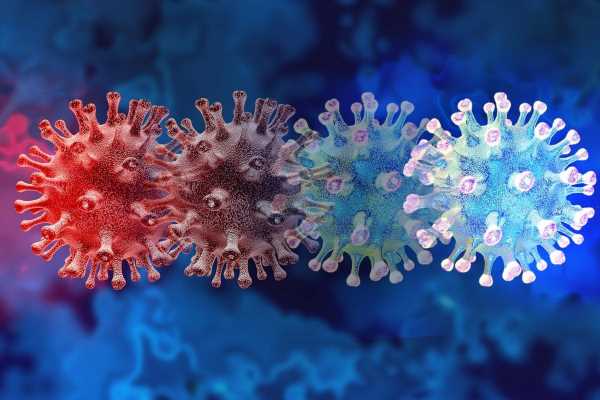Evolution of SARS-CoV-2 variants of concern
In a recent study posted to the bioRxiv* preprint server, researchers investigated the evolution of different severe acute respiratory syndrome coronavirus 2 (SARS-CoV-2) variants of concern (VOCs).

Background
Novel variants of SARS-CoV-2 have been reported to differ from the previous variants in terms of improved transmission and more robust antibody evasion. While genomic surveillance of the virus has been consistently increased to curb coronavirus disease 2019 (COVID-19) infections, there is not enough knowledge regarding the evolution of the SARS-CoV-2 VOCs.
Between-host model of VOC emergence
In the present study, researchers examined the association between the emergence of SARS-CoV-2 VOCs and persistent transmission chains between individuals infected with acute COVID-19 or prolonged infections.
The team defined the effective virus population size as Ne=N/σ2 where N is the number of infectious individuals in the world and σ2 is the variance in secondary cases or the offspring number. Each acute infection detected was treated as one generation, wherein it was assumed that one virion was responsible for one transmission. The virus mutation rate was defined as μ per base per generation. In the case of mutant virus populations having a selective advantage in comparison to the background, the average offspring number was found to increase by a factor of 1+s.
Fitness landscapes
The team investigated the probable effects of the fitness landscape on viral dynamics by analyzing the three limiting landscapes, namely landscapes 1, 2, and 3 that spanned a distinct range of biologically possible scenarios. These landscapes are characterized between-host fitness using an effective substitution rate. In all the three landscapes assessed, the peak was a VOC phenotype which had an advantage with respect to fitness as compared to its ancestor variant. The team assumed that SARS-CoV-2 Alpha, Beta, and Gamma VOCs were similar enough to be described using the same landscape and value of s, which was observed for the early rate of increase in the transmission of VOCs.
Landscape 1: single mutations
In this landscape, a single mutation was required to confer fitness advantages to a variant against the genetic background of existing SARS-CoV-2 lineages. The team observed that under high levels of overdispersion, landscape 1 could match the long waiting time required for the emergence of the first VOC. However, such overdispersion levels are not evidenced by any of the available studies conducted on the transmission of SARS-CoV-2. This landscape only rarely produced an evolutionary environment that could represent the emergence and distribution of the SARS-CoV-2 Alpha, Beta, and Gamma VOCs.
Overall, landscape 1 predicted similar waiting periods for the emergence of the three VOCs which was inconsistent with the existing evidence. Hence, the team found no likely combination of factors that could result in the emergence of SARS-CoV-2 VOCs as per landscape 1.
Landscape 2: additive mutations
This landscape was associated with evolutionary pathways having K>1 major mutations responsible for the emergence of SARS-CoV-2 VOCs, with each K making a contribution of ≈s/K to variant fitness. When the team assumed that viral evolution was incident on a whole population level, it was observed that for a range of combinations of parameters, this landscape required up to four distinct mutations to generate appropriately long waiting time periods. Moreover, for combinations with more than four mutations, VOC lineages did not show emergence for any parameter combinations for mutation rate, selective coefficient, and effective population size.
The team also noted that the sequential fixation of viral mutations present at the population level indicated that the intermediate mutations were identifiable many months before the emergence of new VOCs. This too was inconsistent with the existing evidence around the world. The sequential fixation dynamics represented by the landscape generated a ladder-like phylogenetic association between the genetic background and the mutant populations wherein each new VOC mutation attained predominance before resulting in new lineages having novel mutations. The team also remarked that such a scenario was possible for SARS-CoV-2 only over longer time periods of evolution.
Landscape 3: fitness plateau crossing
Similar to landscape 2, landscape 3 represented evolutionary pathways involving K>1 major mutations responsible for the production of new SARS-CoV-2 VOCs. However, in landscape 3, the full K-mutant VOC genotype had a considerable selective advantage with respect to the background population. The team observed that only plateau crossing with K=2 was consistent with the waiting time period associated with the emergence of SARS-CoV-2. Plateaus requiring K>2 mutations needed significantly longer to cross and most of the parameter combinations resulted in either zero or one lineage.
Overall, the study findings showed that the waiting period for the emergence of SARS-CoV-2 VOCs along with the existing viral dynamics along with the required number of mutations in the previous VOC lineages was compatible with the VOC phenotype requiring several mutations as well as the VOCs that evolved within individuals having long-term COVID-19 infections.
*Important notice
bioRxiv publishes preliminary scientific reports that are not peer-reviewed and, therefore, should not be regarded as conclusive, guide clinical practice/health-related behavior, or treated as established information.
- Mahan Ghafari, Qihan Liu, Arushi Dhillon, Aris Katzourakis, Daniel Weissman. (2022). Investigating the evolutionary origins of the first three SARS-CoV-2 variants of concern. bioRxiv. doi: https://doi.org/10.1101/2022.05.09.491227 https://www.biorxiv.org/content/10.1101/2022.05.09.491227v1
Posted in: Medical Science News | Medical Research News | Disease/Infection News
Tags: Antibody, Coronavirus, Coronavirus Disease COVID-19, covid-19, Evolution, Genetic, Genomic, Mutation, Phenotype, Respiratory, SARS, SARS-CoV-2, Severe Acute Respiratory, Severe Acute Respiratory Syndrome, Syndrome, Virus

Written by
Bhavana Kunkalikar
Bhavana Kunkalikar is a medical writer based in Goa, India. Her academic background is in Pharmaceutical sciences and she holds a Bachelor's degree in Pharmacy. Her educational background allowed her to foster an interest in anatomical and physiological sciences. Her college project work based on ‘The manifestations and causes of sickle cell anemia’ formed the stepping stone to a life-long fascination with human pathophysiology.
Source: Read Full Article
